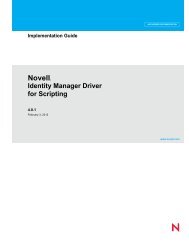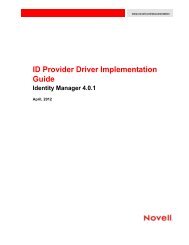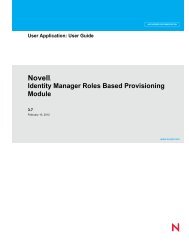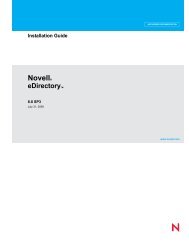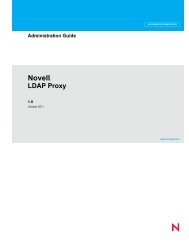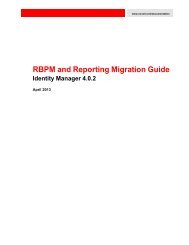Novell eDirectory 8.8 Troubleshooting Guide - NetIQ
Novell eDirectory 8.8 Troubleshooting Guide - NetIQ
Novell eDirectory 8.8 Troubleshooting Guide - NetIQ
You also want an ePaper? Increase the reach of your titles
YUMPU automatically turns print PDFs into web optimized ePapers that Google loves.
5<strong>Troubleshooting</strong> LDIF Files<br />
The <strong>Novell</strong> Import Conversion Export utility lets you easily import LDIF files into and export LDIF<br />
files from <strong>eDirectory</strong>. For more information, see “<strong>Novell</strong> Import Conversion Export Utility” in the<br />
<strong>Novell</strong> <strong>eDirectory</strong> <strong>8.8</strong> Administration <strong>Guide</strong>.<br />
In order for an LDIF import to work properly, you must start with an LDIF file that the <strong>Novell</strong><br />
Import Conversion Export utility can read and process. This section describes the LDIF file format<br />
and syntax and provides examples of correct LDIF files.<br />
• Section 5.1, “Understanding LDIF,” on page 21<br />
• Section 5.2, “Debugging LDIF Files,” on page 29<br />
• Section 5.3, “Using LDIF to Extend the Schema,” on page 33<br />
5.1 Understanding LDIF<br />
LDIF is a widely used file format that describes directory information or modification operations<br />
that can be performed on a directory. LDIF is completely independent of the storage format used<br />
within any specific directory implementation, and is typically used to export directory information<br />
from and import data to LDAP servers.<br />
LDIF is usually easy to generate. This makes it possible to use tools like awk or perl to move data<br />
from a proprietary format into an LDAP directory. You can also write scripts to generate test data in<br />
LDIF format.<br />
5.1.1 LDIF File Format<br />
<strong>Novell</strong> Import Conversion Export imports require LDIF 1 formatted files. The following are the<br />
basic rules for an LDIF 1 file:<br />
• The first noncomment line must be version: 1.<br />
• A series of one or more records follows the version.<br />
• Each record is composed of fields, one field per line.<br />
• Lines are separated by either a new line or a carriage return/new line pair.<br />
• Records are separated by one or more blank lines.<br />
• There are two distinct types of LDIF records: content records and change records. An LDIF file<br />
can contain an unlimited number of records, but they all must be of the same type. You can’t<br />
mix content records and change records in the same LDIF file.<br />
• Any line beginning with the pound sign (#) is a comment and is ignored when processing the<br />
LDIF file.<br />
5.1.2 LDIF Content Records<br />
An LDIF content record represents the contents of an entire entry. The following is an example of an<br />
LDIF file with four content records:<br />
5<br />
novdocx (ENU) 01 February 2006<br />
<strong>Troubleshooting</strong> LDIF Files<br />
21




